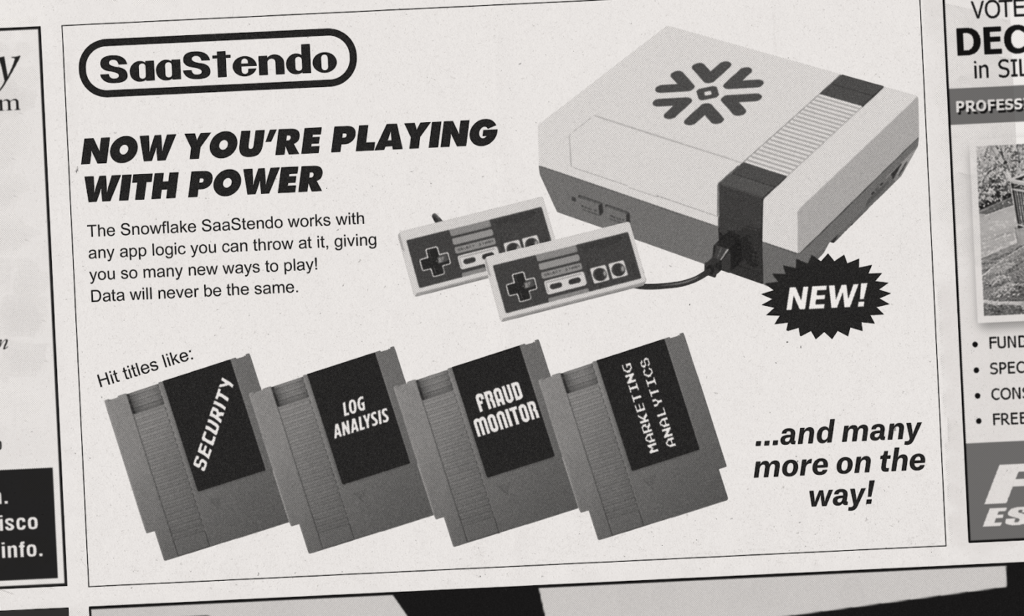

Snowflake Will Catalyze A New Generation Of Apps
The best products don’t just massively expand their markets, they also create new ecosystems around themselves. The iPhone is a famous example, taking the smartphone from luxury to necessity and creating an ecosystem of new mobile apps from third-party developers. The same is true for Zoom, which has made video conferencing ubiquitous and enabled fitness trainers, educators and many others to deliver new services over video.
Snowflake is the latest great product to follow in their footsteps. It doesn’t just create a delightful experience around data storage, massively expanding its product category; it also creates new opportunities for startups and entrepreneurs by disaggregating data from applications. Previously, companies would bring their data to applications; now they can keep it all in one place, and bring application logic to the data. Think of it as the “Nintendo phase of SaaS”, where there’s a common data substrate and companies can just put in whatever “app cartridge” they need into the “Snowflake console”.
To recap, Snowflake is an analytical data warehouse built for the cloud. Historically, analytical data stores have been the smaller step-child of relational databases. It’s the difference between a company like Teradata, with a $2.5 billion market cap, and Oracle, which is valued at $180 billion. But Snowflake’s rapid growth suggests that’s changing. There’s never been a greater supply of data from logs or events, or greater demand from companies to analyze it.
Snowflake satisfies that need by combining the performance of traditional data warehouses like Teradata or Netezza, with the flexibility and scale of big data solutions like Cloudera or Hortonworks. That’s all delivered with the convenience and ease of use of the cloud. The result is rabid customer love, reflected in the rapid growth of new customers and best-in-class cohort expansion within existing ones. Snowflake’s success is all the more remarkable for the fact that Amazon has a directly competitive product, Redshift, that offers a “good enough” solution. Customers still choose Snowflake because of its elegant architecture, superior user experience and product design.
The growth of cloud-based data warehouses like Snowflake or Redshift has already spurred innovation in adjacent product categories. Data ingestion companies like Fivetran or Matillion have seen rapid growth. Old processes like ETL (export, transform, load) have been redefined to ELT (export, load, transform), with transformation now moved into the data warehouse, helped by new companies like Fishtown (data build tool). New open source companies like Cube Dev make it easier to integrate data pipelines.
Even more interesting is the potential to build new analytical applications leveraging the data in Snowflake. Some companies will still favor the convenience of fully integrated applications like Amplitude or Sumo. But others will prefer to consolidate a single copy of their data, which they can then make available to developers. For new app providers, this helps get over the “cold start problem”, since they can more easily populate their apps with enterprise data. New application companies are also spared the cost and headache of data storage, accelerating innovation and enabling them to price more aggressively. Internal enterprise developers can experiment with custom apps to make their teams more efficient, perhaps leveraging a generation of new low/no code app builders.
All this could spur a new generation of apps, built on the foundation of easily accessible “big data” in the cloud. By freeing applications from worrying about data storage, Snowflake lets app developers focus on their own strengths of analytics, data enrichment, collaboration, reporting, or entirely new ways of extracting value from enterprise data. These new apps could challenge incumbents in mature categories like security, log analysis, fraud monitoring, customer data management, marketing analytics, and many others.
There are lots of reasons to cheer for Snowflake. The founders, including Mike Speiser at Sutter Hill, are the kind of humble, talented, driven people that you want to win. It’s great to see a best-of-breed product gain share over the cloud infrastructure giants. But perhaps the biggest reason is that Snowflake creates a new center of gravity in the ecosystem. It disaggregates data from application logic. That unbundling and greater specialization should, in turn, unlock a host of new, compelling application companies. We can’t wait to meet them.
My thanks to Ajay Agarwal, Stefan Cohen, John Komkov, Enrique Salem, Annis Steiner and Kevin Zhang for their feedback on this post.
Related Insights


MagicSchool’s AI-Powered Software Is Ushering in the Future of K-12 Teaching
MagicSchool founder Adeel Khan is a former teacher and principal whose AI platform is saving teachers time, fighting burnout, and helping schools build responsible AI experiences for students.

Norm Ai Is Using AI to Clean Up the ‘Sludge’ of Regulatory Compliance
John Nay, a founder at the intersection of AI and law, built Norm Ai as a solution to aid compliance officers in highly regulated industries.
